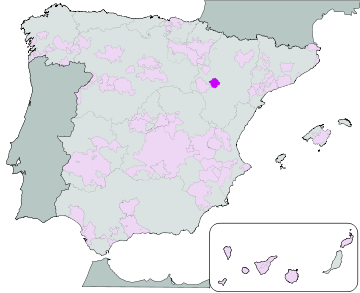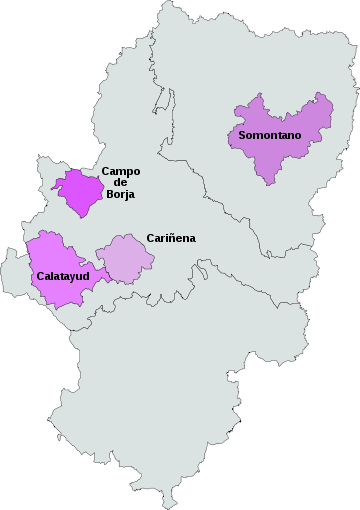
Cariñena (DO)
Encyclopedia


Denominación de Origen
Denominación de Origen is part of a regulatory classification system primarily for Spanish wines but also for other foodstuffs like honey, meats and condiments. In wines it parallels the hierarchical system of France and Italy although Rioja and Sherry preceded the full system...
(DO) for wines located in Cariñena
Cariñena, Aragon
Cariñena is a village in the province of Zaragoza, in the autonomous community of Aragon, Spain. It is the capital of the comarca Campo de Cariñena. It is known for its wine and the cariñena grape, to which it gave its name...
, Aragón
Aragon
Aragon is a modern autonomous community in Spain, coextensive with the medieval Kingdom of Aragon. Located in northeastern Spain, the Aragonese autonomous community comprises three provinces : Huesca, Zaragoza, and Teruel. Its capital is Zaragoza...
, Spain
Spain
Spain , officially the Kingdom of Spain languages]] under the European Charter for Regional or Minority Languages. In each of these, Spain's official name is as follows:;;;;;;), is a country and member state of the European Union located in southwestern Europe on the Iberian Peninsula...
. It is one of the oldest protected growing areas in Europe, the DO having been created in 1932. Cariñena vineyard
Vineyard
A vineyard is a plantation of grape-bearing vines, grown mainly for winemaking, but also raisins, table grapes and non-alcoholic grape juice...
s are located near the centre of Aragón, about 50 km southwest of Zaragoza
Zaragoza
Zaragoza , also called Saragossa in English, is the capital city of the Zaragoza Province and of the autonomous community of Aragon, Spain...
, on a plateau
Plateau
In geology and earth science, a plateau , also called a high plain or tableland, is an area of highland, usually consisting of relatively flat terrain. A highly eroded plateau is called a dissected plateau...
known as the Campo de Cariñena
Campo de Cariñena
Campo de Cariñena is a comarca in central Aragon, Spain. It is located in Teruel Province, in the transitional area between the Iberian System and the Ebro Valley. The most important town is Cariñena....
. The lower vineyards lie at an altitude of 400 m, rising to 800 m as they approach the Sierra de la Virgen
Sierra de la Virgen
Sierra de la Virgen is a mountain range in the Aranda and Comunidad de Calatayud comarcas, Aragon, Spain. It is located south of the Moncayo Massif between the valleys of the Jalón and the Aranda rivers, rising north of the N-234 road, roughly between Calatayud and Torrelapaja.The ridge is aligned...
mountains. To the west they border on the Calatayud (DO)
Calatayud (DO)
Calatayud is a Spanish Denominación de Origen for wines located in the southwestern corner of the province of Zaragoza about 90 km from Zaragoza and covers over 5,600 ha, extending over 46 different municipalities, including Calatayud itself...
.
The 1990s was a period of rapid development due partly to the numerous mergers of small wineries and cooperatives, and to the adaptation of the wines produced to a more modern palette. The traditional robust, high alcohol
Alcohol
In chemistry, an alcohol is an organic compound in which the hydroxy functional group is bound to a carbon atom. In particular, this carbon center should be saturated, having single bonds to three other atoms....
content wine
Wine
Wine is an alcoholic beverage, made of fermented fruit juice, usually from grapes. The natural chemical balance of grapes lets them ferment without the addition of sugars, acids, enzymes, or other nutrients. Grape wine is produced by fermenting crushed grapes using various types of yeast. Yeast...
s are still produced for local consumption, but now fruitier, lighter and well balanced wines are also produced in response to the tastes and preferences of the average export consumer. Exports have quadrupled since 1995 and a new research centre is helping to improve production.
The region is the acknowledged source of the French Carignan grape, which is also grown in Italy
Italy
Italy , officially the Italian Republic languages]] under the European Charter for Regional or Minority Languages. In each of these, Italy's official name is as follows:;;;;;;;;), is a unitary parliamentary republic in South-Central Europe. To the north it borders France, Switzerland, Austria and...
, California
California
California is a state located on the West Coast of the United States. It is by far the most populous U.S. state, and the third-largest by land area...
and several other New World
New World wine
New World wines are those wines produced outside the traditional wine-growing areas of Europe, in particular from Argentina, Australia, Canada, Chile, New Zealand, South Africa and the United States.-Early wines in the Americas:...
regions. The grape is still widely grown in Cariñena, where it tends to be better-known as Mazuelo.
History
The ancient Romans founded the city of Carae in the year 50 BC in an area where the local population had been producing meadMead
Mead , also called honey wine, is an alcoholic beverage that is produced by fermenting a solution of honey and water. It may also be produced by fermenting a solution of water and honey with grain mash, which is strained immediately after fermentation...
since the 3rd century BC. During the Middle Ages
Middle Ages
The Middle Ages is a periodization of European history from the 5th century to the 15th century. The Middle Ages follows the fall of the Western Roman Empire in 476 and precedes the Early Modern Era. It is the middle period of a three-period division of Western history: Classic, Medieval and Modern...
grape-growing and wine-making prospered under the protection of several monasteries, and by the 16th century vineyards covered 50% of the territory of the province of Zaragoza.
Climate
The climate is continental (long, hot summers, cold winters) with extremes of temperatureTemperature
Temperature is a physical property of matter that quantitatively expresses the common notions of hot and cold. Objects of low temperature are cold, while various degrees of higher temperatures are referred to as warm or hot...
over the course of the year: 38°C in summer and -8°C in winter. The “cierzo” a cold northerly wind, helps to keep the humidity low. The main problems for the grape-growers are the risk of hailstones, the strong winds and excessive summer heat, as drought can affect the harvest. However the large difference between daytime and night-time temperatures is a positive contributory factor to the characteristic intensity of Cariñena wines.
Soil
The topsoilTopsoil
Topsoil is the upper, outermost layer of soil, usually the top to . It has the highest concentration of organic matter and microorganisms and is where most of the Earth's biological soil activity occurs.-Importance:...
is reddish-brown limestone
Limestone
Limestone is a sedimentary rock composed largely of the minerals calcite and aragonite, which are different crystal forms of calcium carbonate . Many limestones are composed from skeletal fragments of marine organisms such as coral or foraminifera....
over a subsoil
Subsoil
Subsoil, or substrata, is the layer of soil under the topsoil on the surface of the ground. The subsoil may include substances such as clay and/or sand that has only been partially broken down by air, sunlight, water, wind etc., to produce true soil...
of loose rock with a high calcium carbonate
Calcium carbonate
Calcium carbonate is a chemical compound with the formula CaCO3. It is a common substance found in rocks in all parts of the world, and is the main component of shells of marine organisms, snails, coal balls, pearls, and eggshells. Calcium carbonate is the active ingredient in agricultural lime,...
content, and in some places, slate
Slate
Slate is a fine-grained, foliated, homogeneous metamorphic rock derived from an original shale-type sedimentary rock composed of clay or volcanic ash through low-grade regional metamorphism. The result is a foliated rock in which the foliation may not correspond to the original sedimentary layering...
and clay
Clay
Clay is a general term including many combinations of one or more clay minerals with traces of metal oxides and organic matter. Geologic clay deposits are mostly composed of phyllosilicate minerals containing variable amounts of water trapped in the mineral structure.- Formation :Clay minerals...
.
Grape Varieties
The most widely planted variety is Garnacha Tinta (55%) which is used to produce reds and rosés, followed by Mazuelo and TempranilloTempranillo
Tempranillo is a variety of black grape widely grown to make full-bodied red wines in its native Spain. It is the main grape used in Rioja, and is often referred to as Spain's "noble grape". Its name is the diminutive of the Spanish temprano , a reference to the fact that it ripens several weeks...
(15%), while Viura (20%) is common for whites. Growers are also experimenting with foreign varieties such as Chardonnay
Chardonnay
Chardonnay is a green-skinned grape variety used to make white wine. It is originated from the Burgundy wine region of eastern France but is now grown wherever wine is produced, from England to New Zealand...
and Parellada
Parellada
Parellada is a white grape variety of Catalan origin specially grown in Catalonia. With Macabeu and Xarel·lo, is one of the three traditional varieties used to make the sparkling wine Cava, which is primarily produced in Catalonia...
which have opened up the range of wines produced considerably in recent years. Most vines are planted on trellises (en espaldera) in marco real layout with 3 m between rows and a planting density of between 1500 and 3000 vines/ha. The harvest generally starts in September.
Wine Production
Red wines are produced ensuring that malolactic fermentationMalolactic fermentation
Malolactic fermentation is a process in winemaking where tart-tasting malic acid, naturally present in grape must, is converted to softer-tasting lactic acid. Malolactic fermentation tends to create a rounder, fuller mouthfeel. It has been said that malic acid tastes of green apples...
has been completed, though carbonic maceration
Carbonic maceration
Carbonic maceration is a winemaking technique, often associated with the French wine region of Beaujolais, in which whole grapes are fermented in a carbon dioxide rich environment prior to crushing. Conventional alcoholic fermentation involves crushing the grapes to free the juice and pulp from the...
is also used for young wines. Selection for Crianza, Reserva and Gran Reserva starts in the vineyards. Tempranillo is blended with Garnacha
Grenache
Grenache is one of the most widely planted red wine grape varieties in the world. It ripens late, so it needs hot, dry conditions such as those found in Spain, the south of France, and California's San Joaquin Valley. It is generally spicy, berry-flavored and soft on the palate with a relatively...
to make the Crianza.
The whites are made with Viura and the rosés use Garnacha along with other white and red varieties.
The rosés do not undergo malolactic fermentation, so as to conserve all their acidity, and are macerated
Maceration (wine)
Maceration is the winemaking process where the phenolic materials of the grape— tannins, coloring agents and flavor compounds— are leached from the grape skins, seeds and stems into the must. Maceration is the process by which the red wine receives its red color, since 99% of all grape juice is...
for colour.
Wines Produced
Both the fresh young whites and rosé wines produced in Cariñena are best consumed within the year of production.Reds have the characteristic style of Garnacha wines produced in hot climates and, in the case of oak-aged Crianzas, have the taste and strength provided by 5% of Cariñena (Carignan) grapes. Dry whites represent 20% of total production. Sweet Moscatels, for which the region has long been famous, are still produced in quantity from the Moscatel Romano grape.

